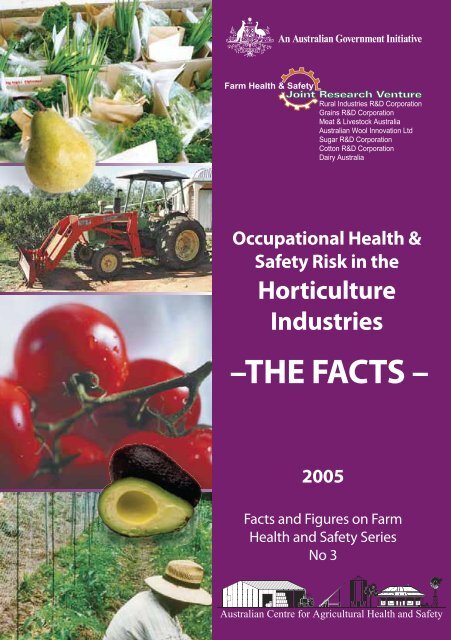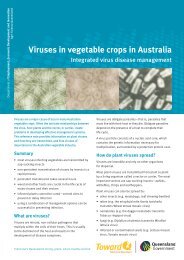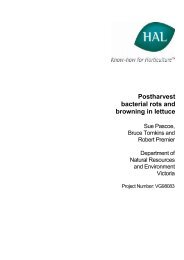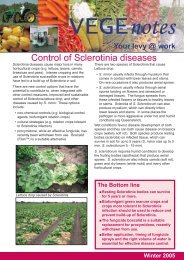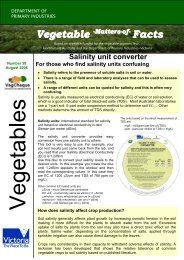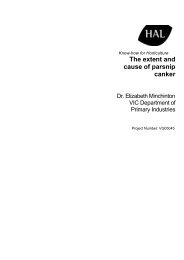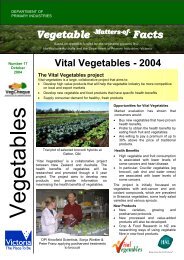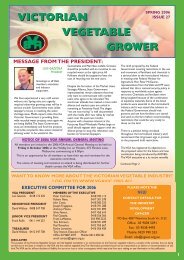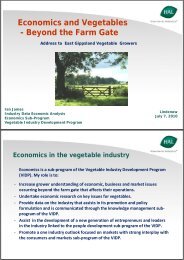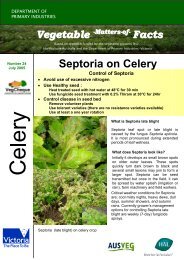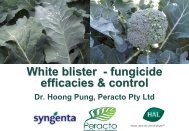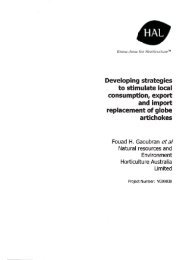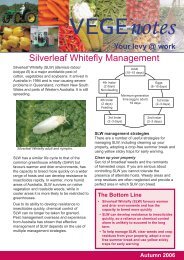Horticultural Safety Guide
Horticultural Safety Guide
Horticultural Safety Guide
You also want an ePaper? Increase the reach of your titles
YUMPU automatically turns print PDFs into web optimized ePapers that Google loves.
Occupational Health &<strong>Safety</strong> Risk in theHorticultureIndustries–THE FACTS –2005Facts and Figures on FarmHealth and <strong>Safety</strong> SeriesNo 3
Contents1. Introduction 42. Horticulture industries in Australia 53. Injury deaths—all agriculture sectors 64. Deaths on horticulture production farms 85. Workers’ compensation claims 96. Agency of workers’ compensation claims 107. Mechanism of injury of workers’ compensation claims 118. Noise and hearing loss 129. Pesticides 13References and Contacts 143
1. IntroductionAgriculture and horticulture enterprises produce commodities of more than $30 billion valueper annum on around 135 000 enterprises spread across all states of Australia. However, thatproduction is associated with a high cost in terms of human injury. High rates of serious injuryand deaths on Australian farms are of concern to agricultural industry bodies, farmers, workersand farm enterprises and federal and state governments.Farmsafe Australia, the national association of agencies with a commitment to reducing injuryrisk on Australian farms, is working with the horticultural industries to implement the Health and<strong>Safety</strong> in the <strong>Horticultural</strong> Industry: An Industry Strategy 2004-2009.Strategic approaches to reducing farm injury risk are multifaceted and include:- identifying elimination and substitution options- improving design and engineering solutions- administrative or work practice solutions, including education and skills development- identification of requirements for personal protective clothing and equipment- identification of incentives for adoption of improved systems- ensuring compliance with regulatory requirements for supply of safe plant and equipmentand safe operation in the farm workplace.This document has been produced to provide guidance to those agencies and individuals whoare working to reduce risk associated with horticultural production in Australia. The publicationis available electronically for use by educators and speakers in their efforts to raise awarenessand promote horticultural production safety, and for those whose role is the development ofpublic and industry policy to improve safety.4
2. Horticulture industries in Australia<strong>Horticultural</strong> production – fruit, vegetable and flower production - is currently carried outon an estimated 22,460 rural properties in Australia. <strong>Horticultural</strong> establishments compriseapproximately 16% of all Australian agricultural enterprises. Table 1 indicates the number ofcommercial enterprises reporting undertaking horticultural production in 2002.Table 1 Establishments undertaking agricultural activity, Australia 30 June 2002NSW Vic. Qld SA WA Tas NT ACT Aust.Plant nurseries 858 340 625 130 189 52 21 5 2,220Cut flower/flower seed 263 224 185 87 140 38 9 - 945Vegetable growing 831 1,011 1,379 513 517 545 9 - 4,805Grape growing 1,220 2,243 167 2,448 628 119 4 4 6,833Apple/pear growing 176 307 37 108 154 137 - 1 919Stone fruit growing 435 294 114 195 178 41 - 1 1,258Kiwi fruit growing 24 4 3 - 4 - - - 34Fruit growing nec 1,881 510 2,018 560 318 43 116 - 5,446Grain growing 4,193 2,996 1,715 4,120 2,851 33 2 - 15,911Grain-sheep/beef cattle 6,669 2,824 1,289 1,915 2,860 52 - 1 15,610Sheep-beef cattle 3,726 2,288 867 795 453 269 - 26 8,424Sheep farming 5,588 4,218 444 1,515 1,436 679 - 30 13,911Beef cattle farming 10,722 7,698 11,285 1,234 1,893 1,048 211 19 34,110Dairy cattle farming 1,615 6,696 1,292 590 358 580 3 1 11,135Poultry farming (meat) 339 186 126 67 58 14 1 - 790Poultry farming (eggs) 130 152 84 30 61 18 5 1 481Pig farming 399 192 328 124 87 27 1 - 1,159Horse farming 631 389 516 ^57 129 53 - 3 1,777Deer farming 28 38 ** 21 ** 11 - - 125Livestock nec 311 133 194 14 66 6 2 - 725Sugar cane growing 521 ** 4,219 - 5 - - - 4,747Cotton growing 321 - 375 - - - - - 697Crop/plant nec 214 536 616 130 108 190 11 1 1,806Total 41,092 33,282 27,900 14,654 12,499 3,953 395 93 133,868Source: Australian Bureau of Statistics. Agricultural Commodities, Australia, 2001-02 (7121.0).Figure 1 Area under production of vegetables, fruit and nuts and grapes, Australia (1994/95-2001/02)production ('000ha)Area under190170150130110907050Source: ABS (2002)94/9595/966/9 9797/9898/9999/0000/0101/02VegetablesFruit and nutsGrapes5
3. Injury deaths—all agriculture sectorsTable 2 indicates the causes of non-intentional traumatic death of those persons whoseoccupation at time of death was farmer, farm manager or farm worker, for the years 1999 to2002, and covers claims from all agricultural industries including horticultural enterprises. Thedata does not include fatalities of visitors such as children or students or other occupationalgroups such as tradespersons or contractors working in the farm workplace but does includeinjury deaths associated with on-road transportation accidents.Table 2 Causes of injury deaths of those whose occupation was farm manager or agricultural worker whodied 1999-2002, Australia (ICD 10-AM)CodeNo Descriptions 99 00 01 02 Z %V01-09 Pedestrian injured in transport accidents 8 14 15 7 44 5.3V10-19 Pedal cyclist injured in transport accidents 0 0 1 0 1 0.1V20-29 Motor cycle rider injured in transport accidents 9 4 10 10 33 4.0V30-39 Occupant of three wheeled motor vehicle injured in 0 0 1 0 1 0.1transport accidentV40-49 Car occupant injured in transport accident 50 57 54 68 229 27.8V50-59 Occupant of pick-up truck or van injured in transport 2 1 7 0 10 1.2accidentV60-69 Occupant of heavy transport vehicle injured in transport1 1 1 2 5 0.6accidentV80-89 Other land transport accidents 27 12 19 19 77 9.3V80 Animal ridden 1 1 2 1 5 0.6V84 Special vehicle mainly used in agriculture(tractors) 10 7 10 6 33 4.0V86 Special all-terrain vehicle(ATV) 5 2 5 8 20 2.4V90-94 Water transport accidents 0 3 1 2 6 0.7V95-97 Air & space transport accidents 2 3 5 1 11 1.3W00-19 Falls 15 10 25 13 63 7.6W20-49 Exposure to inanimate mechanical forces 17 19 8 17 61 7.4W20 Struck by thrown, projected or falling object 6 5 4 5 20 2.4W23 Caught, crushed, jammed, pinched in or between 1 1 1 1 4 0.5objectsW25 Contact with sharp glass 0 0 0 1 1 0.1W29 Other powered hand tools & household machinery 0 0 0 1 1 0.1W30 Contact with agricultural machinery 3 5 2 3 13 1.6W31 Contact with other and unspecified machinery 0 1 1 1 3 0.4W33-34 Firearms 6 6 0 4 16 1.9W50-64 Exposure to animate mechanical forces 3 0 2 0 5 0.6W65-74 Accidental drowning & submersion 5 4 11 5 25 3.0W75-84 Other accidental threats to breathing 3 5 3 8 19 2.3W85-99 Exposure to electric current, radiation and external 1 2 3 2 8 1.0ambient air temperature & pressureX00-X09 Exposure to fire, smoke & flames 4 5 8 6 23 2.8X10-X19 Contact with heat & hot substances 0 0 0 1 1 0.1X20-29 Contact with venomous animals & plants 1 0 1 1 3 0.4X30-39 Exposure to forces of nature 1 2 0 1 4 0.5X40-49 Accidental poisoning 16 9 9 4 38 4.6X50-57 Overexertion, travel & privation 0 1 0 0 1 0.1X58-59 Accidental exposure to other & unspecified factors 28 38 26 42 134 16.2Y85-89 Sequelae of external causes of morbidity & mortality 5 2 7 2 16 1.9Total 199 192 217 211 818 100Source: NFIDC ABS Deaths Database (HOIST NSW Health)*Excludes road traffic deaths, medical misadventure and poisoningby medicinals6
3. Injury deaths—all agriculture sectors(continued)Figure 2 demonstrates the relative contribution of causes of injury deaths of Australian farmersand farm workers across all industries, for the period 1990-1998. This data excludes all roadtraffic injury.Figure 2 Causes of non-intentional injury deaths* of farmers and farm workers, Australia 1990-98 (n=912)Poisoning otherAnimal being riddenElectric currentFirearmAir transport accidentsAccidents natural, environmental factorsFire and flamesMotor vehicle non-traffic accidentsAgricultural machinesSubmersion, suffocation and foreign bodiesAccidental fallsSource: NFIDC ABS Deaths Database (HOIST NSW Health)*Excludes road traffic deaths, medical misadventure and poisoning by medicinals0 50 100 150 200 250 300 350 400Although the proportion of these deaths relating specifically to horticultural producers orworkers is not known, many of the injury risks are shared in common between specific groups inthe agriculture sector, and hence the available data should be considered to be broadly relevantto horticulture industries.37
6. Agency of workers’ compensation claimsThe large proportion of workers’ compensation claims are associated with use of non-poweredhand-tools an equipment and with environmental agencies. Mobile plant and equipment arealso important.Table 6 Number of workers’ compensation claims* in the horticulture and fruit growing industries,Australia 1995/96-2000/01Breakdown Agency Female Male TotalMachinery & (mainly) fixed plant 108 350 458Mobile plant & transport 256 930 1186Powered equipment, tools & appliances 35 147 182Non-powered hand-tools, appliances & equipment 648 1746 2394Chemicals & chemical products 27 109 136Materials & substances 224 577 801Environmental agencies 681 1352 2033Animal, human & biological agencies 48 122 170Other & unspecified agencies 520 937 1457Total 2547 6270 8817Source: NOSI Databases. National Occupational Health and <strong>Safety</strong> Website. www.nohsc.gov.au*Duration of absence was greater than one week & excluding travel claimsA more specific breakdown of claims for the period 1994/95 to 1999/00, shows that the followingare the dominant agencies of associated injury/illness claims (numbers):Mobile plant and transport Tractors 244Trailers 124Trolleys/handcarts 73Ploughs/harrows/cultivators 25Self propelled harvesters 104Conveyor belts and escalators 37Power hoists 45Forklift trucks 70Trucks 92Cars and utilities 68Motorcycles 62Powered equipment Chainsaws 32Outdoor environment Holes in ground – outdoor 126Wet oily traffic area 74Fencing 32Vegetation 869Traffic area 348Non-powered handtools and equipment Knives 256Scissors 209Shovels, spades 65Fastening, packaged/fastening equipment 385All of the above need to be considered in programs to improve safety in the horticulturalindustries.10
8. Noise and hearing lossNoise on farms has been well established as posing risk of noise induced hearing loss and tinnitusin farmers and farm workers. The following table indicates the noise levels with recommendedexposure limits for a range of relevant activities on rural properties.Table 8 Average noise levels and recommended exposure limits for common farm machinery andactivitiesMachinery/Worker Positionduring normal operating conditionsNoise level at operator’s earAverage & Range (95% CI)L AeqdB(A)Recommended exposure limits without hearing protection.NB: Noise exposure risk for each activity in the day is cumulativetoward the overall noise exposure risk.**.Air compressors 86 (77- 95) 7 hrs (15 mins - 8 hrs+)All terrain vehicles (ATVs) 86 (84 - 87) 7 hrs (4 - 8 hrs)Angle grinders 98 (96 - 100) 20 mins (15 - 30 mins)Others in workshop 90 (87 - 93) 2 hrs (1 - 5 hrs)Augers 93 (89-96) 1 hr (30 mins – 3 hrs)Bench grinders 99 (94 - 104) 18 mins (5 mins - 1 hr)Others in workshop 89 (82 -96) 3 hrs (40 mins - 8 hrs)Bulldozers 99 (97 - 100) 18 mins (15 - 30 mins)Chainsaws 106 (104 - 107) 3 mins (2 - 5 mins)Others stacking wood 96 (93 - 99) 40 mins (15 - 50 mins)Circular saws 99 (98 - 101) 18 mins (10 - 20 mins)Others in workshop 89 (84 - 94) 3 hrs (1- 8 hrs)Cotton module press 86 (85 - 88) 6 hrs (4 – 8 hrs)Cotton picker 81 (78 – 85) 8 hrs (8 hrs+)Farm trucks 85 (83 - 88) 8 hrs (4 - 8 hrs)Forklifts 84 (81-88) 8 hrs (4 - 8 hrs)Firearms Lpk 140+ dB no exposureHarvesters 83 (75 - 91) 8 hrs (2 - 8 hrs)Irrigation pumps 100 (96 - 104) 15 mins (5 -30 mins)Motorbikes - 2 wheel 81 (70 - 92) 8 hrs (1.5 - 8 hrs+)Packing shed workers 80 (78 - 82) 8 hrs (8 hrs+)Sugarcane harvester 86 7 hrsTractors with cabins 76 (75 - 78) no limitAv. increase with radio on 3 - 5 dB 8 hrs (8 hrs+)Others in field 85 (80 - 90) 8 hrs (2 - 8 hrs+)Tractors without cabins 92 (90 - 93) 1.5 (1 - 2) hrsOthers in field 82 (78 - 86) 8 hrs (6 - 8 hrs+)Source: Farmsafe Australia. Noise Injury Prevention Strategy.2002**For example: If exposed to noisy activity for half the recommended daily limit {eg. Angle grinder for 10 min of a 20 min daily limit}, the remainingnoise exposure in the day should not exceed half the recommended daily limit for another activity {eg. A limit of 4 hrs instead of 8hr on a tractor with aradio}.Cattle property managers need to ensure that all workers are protected from damaging noiselevels.12
9. PesticidesThe horticultural industries have long been identified as being heavily dependent on pesticideuse, where plant treatment chemicals such as insecticides, herbicides and fumigants areimportant for both pre and post harvest treatments.While data which reveals the full extent of the adverse health effects associated with pesticidesis limited, workers’ compensation claims data suggest that workers in the horticultural and fruitgrowing industries may be at greater risk of pesticide exposure than other agricultural industries(Table 9).Table 9 Number of workers’ compensation claims* associated with plant and animal treatment chemicals,by agricultural industry, Australia 2001-2003pIndustryPlant treatmentchemicalsAnimal treatmentchemicalsAll chemicalproductsHorticulture & fruit growing 20 np 37Grain, sheep & beef cattle np 9 21Dairy cattle 0 0 npPoultry 0 0 npOther livestock 0 0 npOther crop np 0 8Total 25 12 78Source: NOS12 Database, NOHSC website January 2005 . 2003p=incomplete year*Duration of absence was greater than one weeknpCase number less than 5Safe handling of pesticides is a priority for action in the horticultural industries.13
References1. Australian Bureau of Statistics (2002). Agricultural Commodities, Australia, 2001-02. Pub no7121.0 ABS, 2002 Canberra2. Australian Bureau Agricultural & Research Economics. Australian Commodities Statistics,2002. ABARE,Canberra3. Farmsafe Australia. Health and <strong>Safety</strong> in the Australian <strong>Horticultural</strong> Industry – An IndustryStrategy 2004-2009 Moree. 20044. Farmsafe Australia (2002). Noise Injury Prevention Strategy for the Australian FarmingCommunity. Farmsafe Australia: Moree5. Franklin R, Mitchell R, Driscoll T, Fragar L. Farm related fatalities in Australia, 1989-1992 .ACAHS, NOHSC and RIRDC 2000.6. National Occupational Health and <strong>Safety</strong> Commission: The NOHSC Online StatisticsInteractive National Workers’ Compensation Statistics Databases NOSI1 and NOSI2.Website www.nohsc.gov.au 2004. Retrieved January 2005.ContactsAustralian Centre for Agricultural Health &<strong>Safety</strong>andNational Farm Injury Data CentrePO Box 256, Moree NSW 2400Ph (02) 6752-8210Rural Industries Research & DevelopmentCorporationPO Box 4776, Kingston, ACT 2604Ph (02) 6272-4819Farmsafe AustraliaPO Box 256, Moree NSW 2400Ph (02) 6752-8210Horticulture Australia LtdLevel 1, 50 Carrington St, Sydney NSW 2000Ph (02) 8295-2300National Farmers FederationNFF House14-16 Brisbane Ave Barton ACT 2604Ph (02) 6273-3855www.acahs.med.usyd.edu.auwww.acahs.med.usyd.edu.au/nfidcwww.rirdc.gov.au/farmhealthwww.farmsafe.org.auwww.horticulture.com.auwww.nff.org.au14
Occupational Health& <strong>Safety</strong> Risk in theHorticultureIndustries– THE FACTS –Agriculture and horticulture enterprises producecommodities of more than $30 billion value perannum on around 135 000 enterprises spreadacross all states of Australia. However, thatproduction is associated with a high cost in termsif human injury. High rates of serious injury anddeaths on Australian farms are of concern toagricultural industry bodies, farmers, workersand farm enterprises and federal and stategovernments.This document has been produced to provideguidance to those agencies and individualswho are working to reduce risk associatedwith horticultural production in Australia. Thepublication is also available electronically foruse by educators and speakers in their effortsto raise awareness and promote horticulturalproduction safety, and for those whose role isthe development of public and industry policy toimprove safety.Downloads can be obtained from:www.rirdc.gov.au


